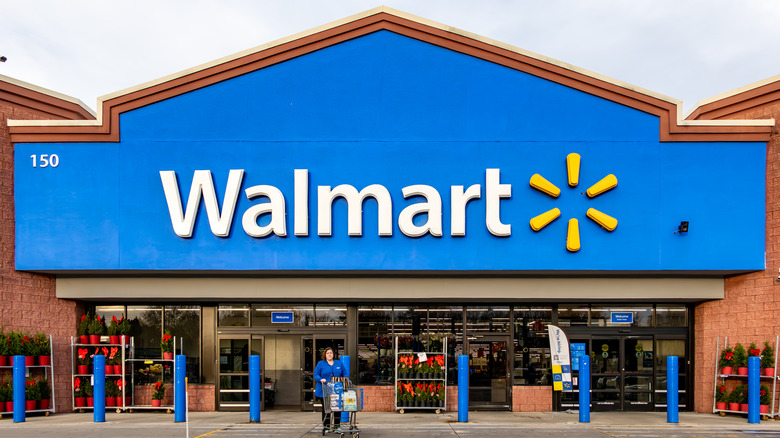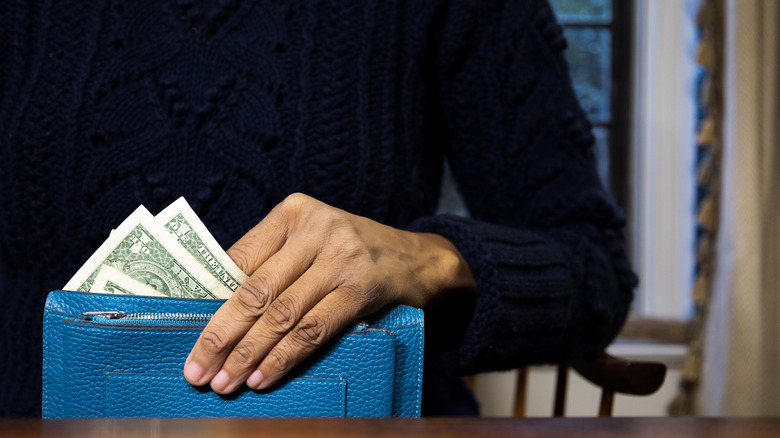The Truth About Grocery Store Money Centers
Regular shoppers at grocery stores like Kroger or even Walmart have probably seen an in-store money center or desk during one of their weekly shopping trips. These financial service options, called MoneyCenter at Walmart and Money Services at Kroger, offer many of the same traditional financial services you might expect to find at your local brick-and-mortar bank branch — or through increasingly popular mobile banking. In fact, Walmart's MoneyCenter, in particular, even offers checking accounts that could allow you to use the service in lieu of a bank altogether — something that can be particularly appealing to those who are unbanked. That said, there are certain conditions to consider.
From financing to checks to money orders, these money centers can serve as a way to quickly and easily get your banking done at the same time as your grocery shopping trip — saving you the hassle of making an extra trip. However, there are some significant downsides to consider, including potentially higher (and hidden) fees, and an increased probability of fraud activity. Since those most likely to be using grocery store money centers are those without more traditional banking options — they are also already generally more at risk of fraud and security issues. It is particularly concerning that those needing these money centers most are also those facing the highest rate of risk by using them in the first place. While you might not feel like you have many other financial options, it's worth considering if the risks of using a money center are worth it.
The hidden costs of using a money center
Most grocery store money centers charge fees for specific banking activities, which can ultimately eat into the money you're hoping to access. For instance, Walmart's MoneyCenter's charge a $4 fee for cashing pre-printed checks under $1,000, but charge an $8 fee for checks between $1,001 and $5,000 — they will not cash checks over $5,000. For personal two-party checks, the check must be under $200 in order to be cashed at a MoneyCenter, and they will charge you $6 to do so. Similarly, money transfers at Walmart also come with added fees, which increase depending on the amount of money being transferred. Kroger, on the other hand, is less upfront about its money center fees, saying that individual rates vary by state.
Another downside when using a grocery store money center has to do with fraud. In 2022, the Federal Trade Commission even sued Walmart for turning a blind eye to scammers defrauding MoneyCenter users out of hundreds of millions of dollars — more than $197 million in confirmed payments, with more than $1.3 billion also potentially connected — between 2013 and 2018. The complaint specifically referenced Walmart's policy of telling employees to issue payouts even when a transaction looked suspicious and failing to have any sort of anti-fraud or consumer protection program. While Walmart did eventually implement this kind of program in late 2014, they had already been operating MoneyCenters for many years before that. The FDIC also included complaints against Walmart's lack of employee training, lack of consumer materials on potential fraud, and its willingness to issue cash for large payment pickups.
Why some customers might use a money center
It's important to realize that those who might have bad credit, or who have experienced financial difficulties in the past, could have difficulty getting a bank account with a more traditional bank. While there are certain things you can do if you are denied a checking, or even savings account, for those needing more immediate access to a financial institution, the money centers at grocery stores can offer an easy solution. This is largely due to the fact that most banks use something known as ChexSystems to check consumer data and information before approving any new potential customers. In addition to allowing banks to watch your spending habits, ChexSystems also keeps a record of things like overdrafts, bouncing a check, and even past fraud issues — usually up to five years prior.
A bad ChexSystems report, and a subsequent denial of a checking account, can make it especially difficult for those with past financial difficulties to ever get themselves out of their predicament. Not having a bank account can make it especially difficult to do everything from cashing your paycheck — since you'll likely have to use a specialized service that charges higher fees — to getting a credit card or loan. All of this is to say, it's no wonder that money centers at retailers like Walmart have only continued to grow in popularity – especially among the unbanked, which the Federal Deposit Insurance Corporation (FDIC) reported comprised 4.5% of all U.S. households in 2021. Whiles fees, and an increased risk of fraud, are not ideal, for many this still serves as a better option than not having a bank option at all.


